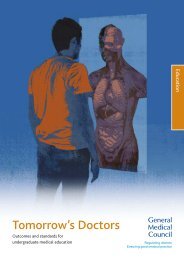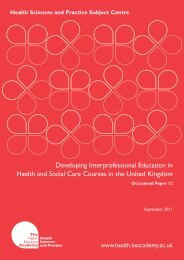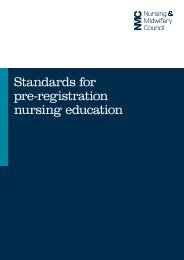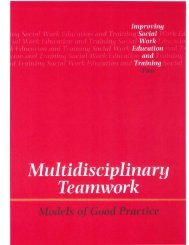Health and Social Care Policy and the Interprofessional ... - CAIPE
Health and Social Care Policy and the Interprofessional ... - CAIPE
Health and Social Care Policy and the Interprofessional ... - CAIPE
You also want an ePaper? Increase the reach of your titles
YUMPU automatically turns print PDFs into web optimized ePapers that Google loves.
The WHO is also calling for a complete overhaul of <strong>the</strong> healthcare workforce<br />
training in order to best meet <strong>the</strong> rapidly increasing number of people living<br />
with long term conditions. The WHO regrets that training of <strong>the</strong> workforce has<br />
not kept pace with <strong>the</strong> changes required in practice. Core competences<br />
applied to all members of <strong>the</strong> workforce are viewed as <strong>the</strong> best way forward<br />
each focusing on a patient centred care model. Core communication skills are<br />
keys to collaboration not only with patients <strong>and</strong> <strong>the</strong>ir carers, but also with<br />
o<strong>the</strong>r health <strong>and</strong> social care providers (WHO 2005).<br />
Integrated <strong>Care</strong><br />
Fragmented models of health <strong>and</strong> social care however remains a persistent<br />
problem, one which causes inefficiency, patient dissatisfaction, impedes<br />
quality <strong>and</strong> accessibility to <strong>the</strong> services required.<br />
The WHO European Office for Integrated <strong>Health</strong> <strong>Care</strong> Services suggests a<br />
working definition of integrated care as:<br />
‘…a concept bringing toge<strong>the</strong>r inputs, delivery, management <strong>and</strong><br />
Organisation of services related to diagnosis, treatment, care,<br />
rehabilitation, <strong>and</strong> health promotion. Integration is a means to improve<br />
services in relation to access, quality, user satisfaction <strong>and</strong> efficiency’<br />
(Gröne & Garcia-Barbero, 2001).<br />
The WHO Framework differentiates between ‘autonomous working’, a ‘coordinated<br />
approach’ <strong>and</strong> ‘integration’. The expert view of integration is that it<br />
is ‘a means to improve services in relation to access, quality, user satisfaction<br />
<strong>and</strong> efficiency’. www.euro.who.int/document/ihb/Trendicreflconissue.pdf<br />
Integrated care is adopted as a broad term for technological, managerial <strong>and</strong><br />
economic aspects of services whereas horizontal integration is viewed as<br />
relating to strategies that link similar levels of care through overcoming<br />
professional <strong>and</strong> departmental boundaries. Vertical integration however<br />
suggests <strong>the</strong> strategies which link primary, secondary <strong>and</strong> tertiary levels of<br />
care whilst continuity of care implies <strong>the</strong> user perspective, in o<strong>the</strong>r words <strong>the</strong><br />
patient’s experience of <strong>the</strong> care package <strong>the</strong>y have received.<br />
Intended for those who need to work toge<strong>the</strong>r to provide care for people with<br />
complex needs <strong>and</strong> <strong>the</strong>ir families, <strong>the</strong> WHO has published <strong>the</strong> Framework as<br />
a web based exercise suitable <strong>the</strong>y suggest for primary health <strong>and</strong> social care<br />
teams where, providing time for learning is protected, a more collaborative<br />
climate will emerge. Examples of where <strong>the</strong> exercise would be most useful<br />
are cited as service provision to children living with disabilities, <strong>and</strong> older<br />
people with mental health problems.<br />
Organisations can use <strong>the</strong> WHO Framework as a basis for mapping emerging<br />
local trends <strong>and</strong> health care needs of <strong>the</strong> population <strong>and</strong> comparing <strong>the</strong>se<br />
with <strong>the</strong> level <strong>and</strong> quality of integration <strong>and</strong> collaboration that has been<br />
achieved. Identifying strengths <strong>and</strong> weaknesses is recommended followed by<br />
an identification of immediate goals to resolve <strong>the</strong>se.<br />
22













